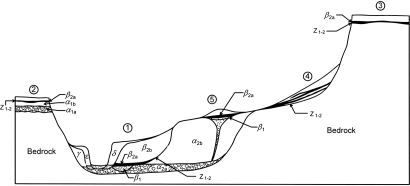Fig. 4.
Generalized stratigraphic profile of an idealized cross-section to show five geomorphic positions of the Younger Dryas black mat (β2a). Position 1 is typical of late Pleistocene-early Holocene alluvial terraces or alluvial fans inset against older Pleistocene deposits (α2). Position 2 is typical of strath terraces where β2a is a cumulic mollic paleosol on loess or fine-grained alluvium overlying strath gravels. Position 3 is typical of uplands where β2a black mat is a wet-meadow paleosol caused by poor drainage or a perched aquifer. Position 4 is found in colluvium or eolian deposits against bedrock uplands with spring seeps where mollic epipedon development is interrupted by either eolian or colluvial deposition. Similar stratigraphy can derive from redeposition of black mat sediments. Position 5 is typical of spring-fed ponds and wetlands where diatomites or marls formed during the YD. In other cases, as spring discharge waned, dark brown to black peaty deposits formed at position 5 during the YD. Position 6, not shown in Fig. 4, represents YD black mats associated with pond or lake shore sediments. Also not shown is position 7 representing cave deposits of YD age.

